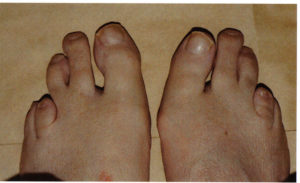There are several diseases and genetic mutations that can affect a human being at the time of birth. The causes of this type of disease are usually genetic and it is very difficult to prevent and avoid some of them from affecting babies. Especially when it comes to rarer diseases, such as Proteus syndrome, for example, which to date has only been documented in 200 cases worldwide, the topic becomes even more delicate, even due to the lack of cases to study. However, there is already a lot of information about the disease and so we are going to explain everything about its symptoms, how it affects a person, how treatments are done, as well as aspects of the life of someone who has the disease.
What is Proteus Syndrome?
This is a congenital disease whose main characteristic is the overgrowth of organs such as bones and skin, among other tissues, in an uncontrolled way. All this growth can lead to gigantism in the limbs, especially the arms and legs. The disease usually does not appear in a baby right at birth, with first symptoms appearing between 6 and 18 months of age. It is an extremely rare disease and that’s why you almost never hear about it, although there are some famous cases. Proteus Syndrome was first described in medicine in the mid-1970s and is named after the Greek god Proteus, who could change shape. But although the description and studies of this disease are relatively recent, there are reports of cases from the 19th century, especially within the famous freak shows that existed at the time. Only in 2011 were researchers able to be certain of the real cause of Proteus Syndrome. It is caused by a mutation in the AKT1 gene, which produces a protein called AKT1 kinase. This protein is one of those responsible for the development and growth of the cells in our body, and a change in this gene ends up causing the disease. Even though cases of Proteus Syndrome are extremely rare, people who have the disease usually suffer a lot because of their appearance, even resulting in serious psychological issues such as depression. It is not possible to detect this mutation during pregnancy and, consequently, it is also not possible to prevent a child from being born with this syndrome.
Symptoms of Proteus Syndrome
Proteus Syndrome can be confused with other diseases exactly because this change in the genes can lead to other health problems. However, this syndrome can be identified through some symptoms such as:
- Gigantism, especially of the feet and hands
- Deformities throughout the body
- Excessive skin folds
- Spine problems
- Heart problems
- Accelerated growth in the early years of life
Some of these symptoms can be mistaken for those of other diseases such as gigantism, for example, but the difference is that Proteus Syndrome occurs in multiple parts of the body and affects the person far beyond just the feet and hands. 
Treatment for Proteus Syndrome
Unfortunately, there is no cure for the disease and treatments are aimed at alleviating some of its main symptoms. Due to the wide variety of problems that a person with this syndrome may present, each treatment will be different from the other. Some patients may have more severe issues with skin overgrowth, which can be partially managed with surgeries. Others have more serious complications involving the spine or heart and need specific medications. Everything will depend on the clinical condition of the patient and what doctors deem necessary.
Limitations for Someone with the Disease
One of the greatest difficulties for a person with Proteus Syndrome is the stigma associated with their physical condition. It is very common for human beings to want to distance themselves from what is considered abnormal, which was even worse some years ago. People in these conditions were sometimes rejected even by their families and forced to look for spaces like freak shows, where they were exhibited as attractions for others to see. Nowadays, respect and awareness about illnesses have made such things disappear, but life for people with this type of disease is still very difficult, especially because of the challenges in socializing and interacting at any level. Many times we avoid talking about certain subjects such as Proteus syndrome, either out of fear or not wanting to think about these kinds of cases. But even though it is rare, knowing more about the disease goes far beyond understanding its causes, symptoms, and treatments. It also serves to show us historically how human prejudice has reached frightening levels and how important it is for us to know what it is about, so as not to make life even harder for people who have this kind of illness. See Also: Hip Dysplasia – Diagnosis, Causes, and Treatment Photo: Hari Jayaram











